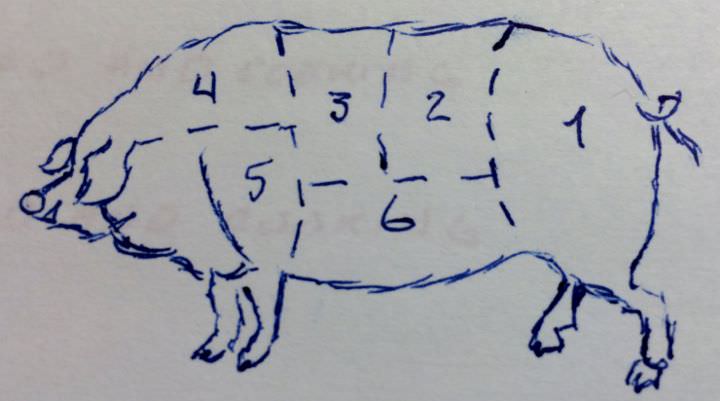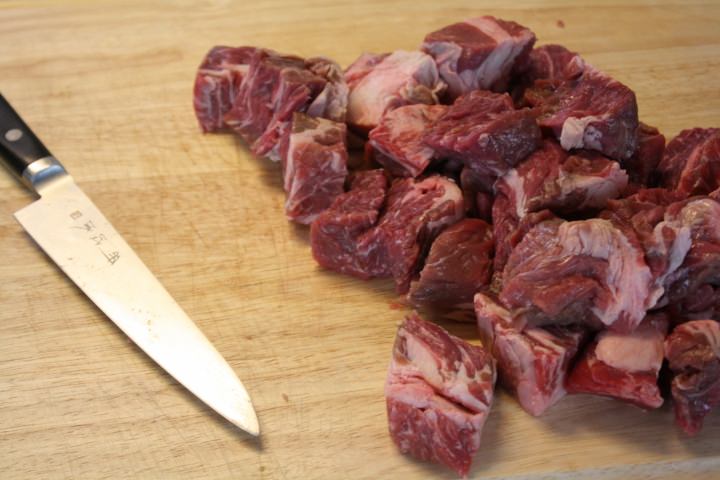USDA Beef Grades
Beef Grades
Are your steaks prime, choice, or select?
Beef grades are based on the amount of marbling in the meat. Marbling is the streaks of fat you find distributed throughout the meat. The age of the animal is considered as well, beef is best when cattle is about 2 years old.
The higher the grade of beef the more tender, juicy, and flavorful the meat will be. However, there is a difference between a cut of meat that has a lot of fat on it, like a NY, and a cut of meat that has a lot of marbling, like rib eye. The rib eye will have a great deal more flavor than the NY, because it has a lot more marbling. A NY has virtually no marbling, all of its fat runs along the top edge of the steak.
Meat with little or no marbling, like NY or filet mignon, will never have the flavor of a rib eye. While a NY has that fat cap along its edge to give it flavor a filet has neither a fat cap nor any marbling. This is the reason you often see it prepared encased in filo dough, topped with foie gras, or wrapped with bacon. You have to do something to give that steak some flavor.
There are eight beef grades used by the USDA.
In order from highest quality to lowest quality, they are:
- Prime
- Choice
- Select
- Standard
- Commercial
- Utility
- Cutter
- Canner
"...Prime beef is produced from young, well-fed beef cattle. It has abundant marbling and is generally sold in restaurants. Prime roasts and steaks are excellent for dry-heat cooking such as broiling, roasting or grilling.
Choice beef is high quality, but has less marbling than Prime. Choice roasts and steaks from the loin and rib will be very tender, juicy, and flavorful and are suited for dry-heat cooking. Many of the less tender cuts can also be cooked with dry heat if not overcooked. Such cuts will be most tender if braised, roasted or simmered with a small amount of liquid in a tightly covered pan.
Select beef is very uniform in quality and normally leaner than the higher grades. It is fairly tender, but, because it has less marbling, it may lack some of the juiciness and flavor of the higher grades. Only the tender cuts should be cooked with dry heat. Other cuts should be marinated before cooking or braised to obtain maximum tenderness and flavor.
Standard and Commercial grades of beef are frequently sold as ungraded or as store brand meat. Utility, Cutter, and Canner grades of beef are seldom, if ever, sold at retail but are used instead to make ground beef and processed products..." Excerpted from USDA blog.
You can read more at the USDA blog, or at Texas A&M's Agriculture and Life Sciences page.
Cuts Of Pork
In butchery, all four legged mammals break down the same way. The butcher makes several primal cuts that break the carcass into sections. These sections are further broken down into wholesale and subsequently retail cuts of meat.
While all mammals break down the same way different regions breakdown wholesale and retail cuts of meat differently. Sometimes it is only the name that is different. For example, in Italy it's all t-bone , there is no such thing as porterhouse. The cuts are essentially the same, only the names are different.
Pork is USDA inspected but it is not graded for consumers. When buying pork, make sure it is pink in color, firm and has some degree of marbling.
 Hog Cut Chart. Yes, I sketched this. It is the same drawing that is tattooed on my forearm.
Hog Cut Chart. Yes, I sketched this. It is the same drawing that is tattooed on my forearm.Section 1: Ham
- Cuts: ham, half ham, ham slice, prosciutto, jamon iberico, culatello
Sections 2 and 3: Loin
- Cuts: loin roast, pork chops, sirloin pork roast, pork tenderloin, baby back ribs, Canadian bacon, butterfly chop
Section 4: Boston Butt or Butt
- Cuts: blade steaks, Boston butt roast, sausage
Section 5: Shoulder or Arm
- Cuts: shoulder hock, arm steak, picnic shoulder
Section 6: Belly
- Cuts: bacon, spareribs, pancetta, salt pork, pork belly,
Tags: beef grades, grades of beef, cuts of pork





